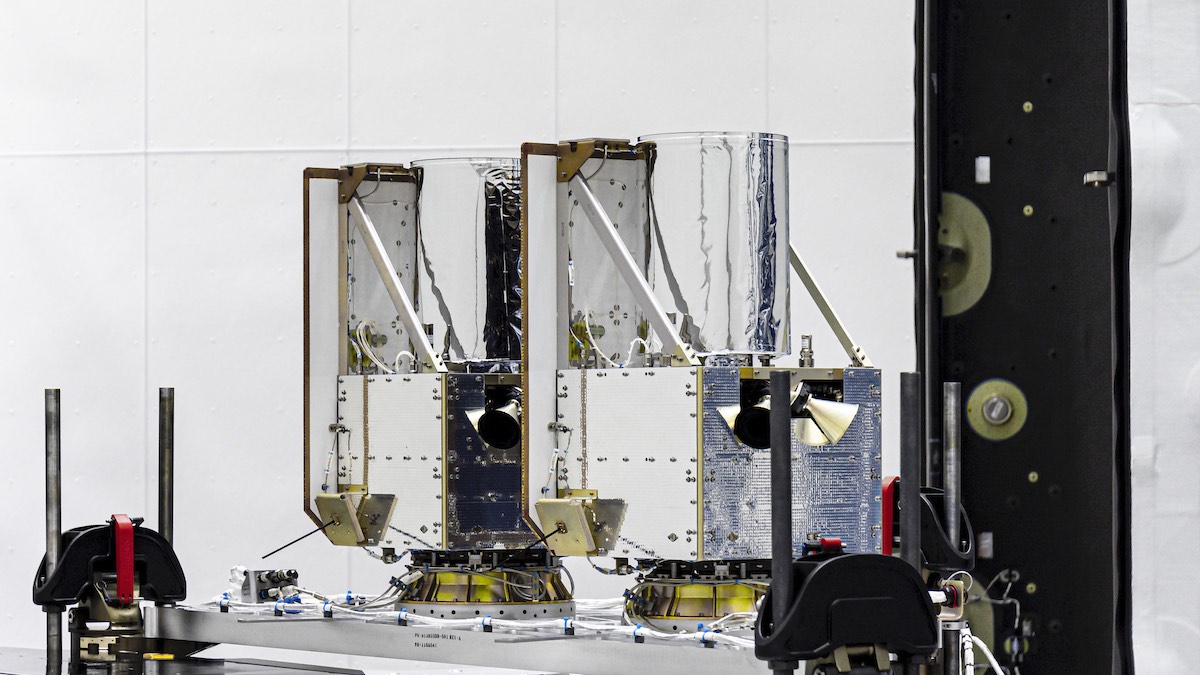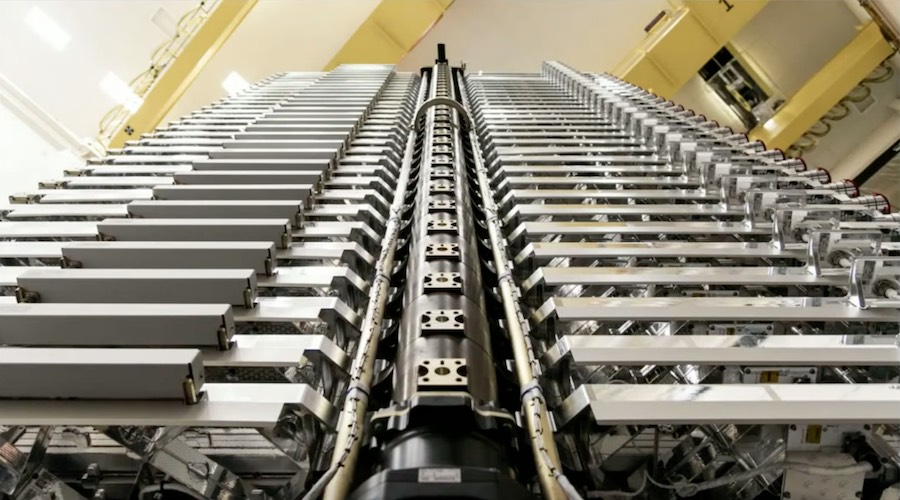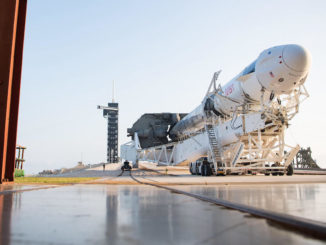EDITOR’S NOTE: SpaceX has scrubbed Friday’s launch attempt.

Despite a growing number of rocket options, the availability of on-time launch services remains a key factor in getting BlackSky’s constellation of Earth-imaging smallsats into orbit. SpaceX’s rideshare launch service will give BlackSky a chance to add two more spacecraft to its fleet Friday on a Falcon 9 rocket with the next batch of Starlink Internet payloads.
BlackSky, based in Seattle, is deploying a fleet of Earth observation satellites designed to monitor changes across Earth’s surface, feeding near real-time geospatial intelligence data to governments and corporate clients.
Scott Herman, BlackSky’s chief technology officer, said this week that the company’s next two satellites are the first off a new assembly line designed to produce spacecraft at a rate of one to two per month. The identical satellites are set for launch at 4:18:02 p.m. EDT (2018:02 GMT) Friday on a Falcon 9 rocket from the Kennedy Space Center in Florida.
There’s a 70 percent chance of good weather for launch Friday from Florida’s Space Coast, according to the U.S. Space Force’s 45th Weather Squadron.
BlackSky is one of several companies developing fleets of small Earth-imaging satellites. Another is Planet, which started on its development before BlackSky and operates more than 100 medium-resolution CubeSats, and 18 bigger SkySat spacecraft with sharper vision.
Planet launched its three newest SkySats as piggyback payloads on a Falcon 9/Starlink launch earlier this month. Like BlackSky, Planet was attracted by SpaceX’s regular launch cadence. Friday’s mission will be SpaceX’s 11th launch of the year, and the eighth SpaceX launch for the Starlink network so far in 2020.
“Probably the biggest dependency on getting the satellites up is the launch schedule,” Herman said. “Because we have this production line cranking the satellites out, it’s really about can we secure the ride that we need, and will those rides stay on schedule. To manage that risk, we use a variety of suppliers, not just SpaceX. We work with the Indian space agency, we we work with Rocket Lab. We’re keeping a close eye on some of the emerging players like Virgin Orbit, Firefly and others, so that we can not only kind of diversify our risk, but increase our cadence of launches and get some more confidence in our launch schedules.”
The BlackSky satellites set for launch Friday are designated Global 7 and Global 8, but they are actually the fifth and sixth operational satellites in the BlackSky fleet.
Herman said BlackSky is comfortable working with SpaceX. Spaceflight Industries, BlackSky’s parent company, has arranged rideshare missions on Falcon 9 rockets for other customers, and the Global 2 satellite launched on a Falcon 9 flight in 2018.
We’ve been working with SpaceX for a long time,” Herman said. “We do work with others — the Indian space agency and Rocket Lab — but we’ve had a pretty deep relationship with SpaceX, and we’re one of their largest customers outside the U.S. government because of all the different rides we’ve been brokering.”

The BlackSky satellites launching Friday are the first produced by LeoStella, a joint venture between Spaceflight Industries and Thales Alenia Space, a major European satellite manufacturer. LeoStella’s production facility is located in Tukwila, Washington, a suburb of Seattle.
The BlackSky spacecraft each weigh around 121 pounds, or 55 kilograms. They have electrothermal propulsion systems that use water as a propellant.
The first four BlackSky Global satellites, which the company built in-house, launched on Indian PSLV, Falcon 9, and Rocket Lab Electron rockets in 2018 and 2019. Two of them launched into polar orbits for global imaging coverage, and two fly in mid-inclination orbits, similar to the pair of BlackSky platforms launching Friday.
BlackSky’s first tech demo pathfinder satellite launched in 2016.
Each of the current generation of BlackSky Global spacecraft can capture up to 1,000 color images per day, with a resolution of about 3 feet (1 meter).
“What we’re doing with the satellites is a little different than what has historically been the commercial remote sensing mission,” Herman said. “Historically, it’s been about mapping missions and getting wider coverage every few years or every few months. What we’re trying to do is build a constellation of satellites — a swarm of satellites — that really allow us to have very high revisit and to have capacity to handle lots and lots of different customer requests, and to be able to collect around the day with dawn to dusk collection.”
Herman said the two satellites launching Friday are the first of BlackSky’s “Generation 2.1” spacecraft. Engineers have introduced refined optics, software, and an improved communications system. In the future, BlackSky will deploy a third generation of BlackSky satellites with sharper resolution level of about 20 inches, or 50 centimeters.
“These next two coming off are a next iteration, basically a version upgrade when you think of it from a software perspective, and they’re based on this assembly line that’s now cranking out these satellites at a rate of about one to two per month,” Herman said. “So this is the beginning of a much faster cadence of getting more and more satellites up and deployed into the constellation.”
“The next two satellites going up are a really important part of that,” he said in an interview with Spaceflight Now. “While we are certainly collecting imagery and doing analytics and doing global monitoring today, each satellite that is added to the constellation gives us more revisit, more capacity, and the ability to service more customers.
“The good news is to move toward our objective architecture of 16 to 24 satellites, we don’t have to wait until we’re all there to achieve critical mass,” Herman said. “It’s not like some of the Internet constellations going, where you need to get a whole bunch of them up before you can even turn the service on. For us, this is an incremental increase in capability, but every satellite we put up provides a pretty dramatic stair-step increase in capability.”
BlackSky could eventually scale up its fleet to 50 or 60 satellites, Herman said, depending on customer demand.
The National Reconnaissance Office, which owns the U.S. government’s spy satellites, awarded study contracts to BlackSky, Planet and Maxar last year to allow government analysts to evaluate the utility of commercial imagery in intelligence-gathering and overhead surveillance.
“Servicing the U.S. government with a site monitoring or an activity monitoring mission is super important,” Herman said.
BlackSky also sees foreign governments, which may not field their own reconnaissance satellites, large multinational companies and the financial industry as other key customers.
Later this year, BlackSky has satellites booked to launch on India’s new Small Satellite Launch Vehicle, or SSLV. But the launch date for that mission, originally scheduled for last year, remains in flux amid development delays on the SSLV, which has not yet flown. The COVID-19 pandemic has also slowed progress on space development in India in recent months.
Herman said BlackSky also plans to launch satellites on Rocket Lab and SpaceX missions later this year. The company says it has eight satellites scheduled for launch before the end of 2020, including the pair launching Friday. But that assumes launch vehicles and spacecraft production don’t face delays.
SpaceX has published pricing information for its smallsat rideshare service. According to SpaceX’s website, the company charges $1 million to launch a 440-pound (200-kilogram) satellite on a rideshare mission. That’s significantly lower than any other launch provider, including small satellite launchers like Rocket Lab’s Electron.
But Rocket Lab and other companies can carry small satellites into orbit on dedicated rides, giving operators more flexibility to choose their altitude and inclination.

The BlackSky satellites launching Friday are stacked on top of an array of 57 Starlink satellites inside the Falcon 9 rocket’s payload shroud.
SpaceX’s Starlink network is designed to provide low-latency, high-speed Internet service around the world. SpaceX has launched 538 flat-panel Starlink spacecraft since beginning full-scale deployment of the orbital network in May 2019, making the company the owner of the world’s largest fleet of satellites.
With Friday’s launch, SpaceX will have delivered 595 Starlink satellites to orbit in the last 13 months.
Each of the flat-panel satellites weighs about a quarter-ton, and are built by SpaceX in Redmond, Washington. Once in orbit, they will deploy solar panels to begin producing electricity, then activate their krypton ion thrusters to raise their altitude to around 341 miles, or 550 kilometers.
The Falcon 9 is targeting deployment of the Starlink and BlackSky satellites Friday in a nearly circular orbit ranging as high as an altitude of 249 miles (401 kilometers), with an inclination of 53 degrees to the equator.
That’s a change from the most recent Starlink launches, when SpaceX placed the satellites into a lower, more egg-shaped orbit after separation from the Falcon 9 rocket. That meant the satellites were closer Earth when they began orbit-raising to their operational altitude, where they will use their antennas to begin signals testing in SpaceX’s Starlink network.
SpaceX says it needs 24 launches to provide Starlink Internet coverage over nearly all of the populated world, and 12 launches could enable coverage of higher latitude regions, such as Canada and the northern United States.
The Falcon 9 can loft up to 60 Starlink satellites — each weighing about a quarter-ton — on a single Falcon 9 launch. But launches with secondary payloads, such as BlackSky’s new Earth-imaging satellites, can carry fewer Starlinks to allow the rideshare passengers room to fit on the rocket.
The initial phase of the Starlink network will number 1,584 satellites, according to SpaceX’s regulatory filings with the Federal Communications Commission. But SpaceX plans launch thousands more satellites, depending on market demand, and the company has regulatory approval from the FCC to operate up to 12,000 Starlink relay nodes in low Earth orbit.
Elon Musk, SpaceX’s founder and CEO, says the Starlink network could earn revenue to fund the company’s ambition for interplanetary space travel, and eventually establish a human settlement on Mars.

But astronomers have raised concerns about the brightness of SpaceX’s Starlink satellites, and other companies that plan to launch large numbers of broadband satellites into low Earth orbit.
The Starlink satellites are brighter than expected, and are visible in trains soon after each launch, before spreading out and dimming as they travel higher above Earth.
SpaceX introduced a darker coating on a Starlink satellite launched in January in a bid to reduce the amount of sunlight the spacecraft reflects down to Earth. That offered some improvement, but not enough for ultra-sensitive observatories like the U.S government-funded Vera Rubin Observatory in Chile, which will collect all-sky images to study distant galaxies, stars, and search for potentially dangerous asteroids close to Earth.
SpaceX launched a satellite June 3 with a new unfolding radio-transparent sunshade to block sunlight from reaching bright surfaces on the spacecraft, such as its antennas.
Earlier this month, SpaceX said all Starlink satellites beginning with the launch scheduled for Friday will carry the sunshades.
Coupled with changes in how the satellites are oriented when they are at lower altitudes soon after launch, the sun visors could alleviate the most serious impacts on astronomy from the Starlink network, and eliminate the Starlink satellites from naked eye vision once they reach their 341-mile-high operational orbit.
The Vera Rubin Observatory’s 3,200-megapixel camera will start astronomical surveys in 2022. Each image will cover a region of the sky the size of 40 full moons, and many of the images will include light streaks left by satellites from the Starlink network, and potentially other satellite constellations.
The worst impacts will come after dusk and before dawn. That’s a time of day when astronomers want to search for asteroids.
Astronomers on the Vega Rubin Observatory team say SpaceX has been working with them since last year to try to reduce the impacts of the Starlink network on their scientific program.
“SpaceX is setting an example for the rest of the industry by doing all of this work to try to darken the satellites,” said Tony Tyson, a professor of physics at the University of California, Davis.
“The Vera Rubin Observatory is actually a limiting case,” said Tyson, the chief scientist on the Vera Rubin Observatory. “The reason why it’s a limiting case (is because) it was built to find something unusual in the sky. It’s the perfect machine unfortunately for running into satellite trails.”
Astronomers illuminated a Vera Rubin imaging detector in a test to see how it would respond to the passage of a satellite as bright as a Starlink. They found the satellite leaves behind not just a single trail, but “ghost” trails away from the spacecraft’s path.
“We have been developing software to try to mitigate these affects, but it only has a (limited) dynamic range,” Tyson said. “The software only begins to work if we could dim these low Earth orbit satellites to something like 7th apparent magnitude. That’s beynd the limit of human vision.”
The spacecraft with the darker coating was measured at 6.1 magnitude once it flew into a higher orbit after launch. SpaceX and astronomers won’t know how effective the visor is at darkening the satellites from the ground until the first sunshade-equipped spacecraft, dubbed VisorSat, reaches its operational altitude of 341 miles.
“We need to get to 7th magnitude,” Tyson said. “VisorSat might actually reach 7. We won’t know for a few months yet, and that’s at 550 kilometers (341 miles) … If it can be darkened to 7th magnitude, then our software would begin to get rid of these electronic ghosts … But it won’t get rid of the main trail.”
“Even if all of this works, the satellite (main) trails will clearly still be there in the data, seriously complicating data analysis and limiting discoveries,” Tyson said.
Email the author.
Follow Stephen Clark on Twitter: @StephenClark1.



